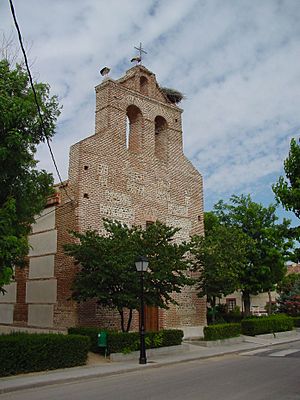Church of San Esteban (Fresno del Torote) facts for kids
Quick facts for kids Church of San Esteban |
|
|---|---|
| Native name Spanish: Iglesia de San Esteban |
|
 |
|
| Location | Fresno de Torote, Spain |
| Official name: Iglesia de San Esteban | |
| Type | Non-movable |
| Criteria | Monument |
| Designated | 1996 |
| Reference no. | RI-51-0009178 |
| Lua error in Module:Location_map at line 420: attempt to index field 'wikibase' (a nil value). | |
The Church of San Esteban (which means Saint Stephen's Church in Spanish) is a beautiful old church. You can find it in a town called Fresno de Torote in Spain. This church is very special! In 1996, it was named a Bien de Interés Cultural. This Spanish phrase means "Property of Cultural Interest." It's like saying the church is a really important historical treasure that needs to be protected.
A Look at Its History and Design
The Church of San Esteban was built a long, long time ago. Construction started in the late 1500s and finished in the early 1600s. That's over 400 years ago!
What Kind of Architecture Is It?
This church shows a mix of two cool styles: Mudéjar and Renaissance architecture.
- Mudéjar style is unique to Spain. It was created by Muslim craftspeople who stayed in Christian Spain after the Reconquista. They used their amazing skills to build Christian buildings. This style often features brickwork, decorative tiles, and horseshoe arches.
- Renaissance architecture came from Italy. It brought back ideas from ancient Roman and Greek buildings. This style often uses columns, domes, and balanced shapes.
The Church of San Esteban combines these two styles. This makes it a great example of how different cultures and ideas came together in Spanish art and building.
See also
 In Spanish: Iglesia de San Esteban (Fresno de Torote) para niños
In Spanish: Iglesia de San Esteban (Fresno de Torote) para niños

